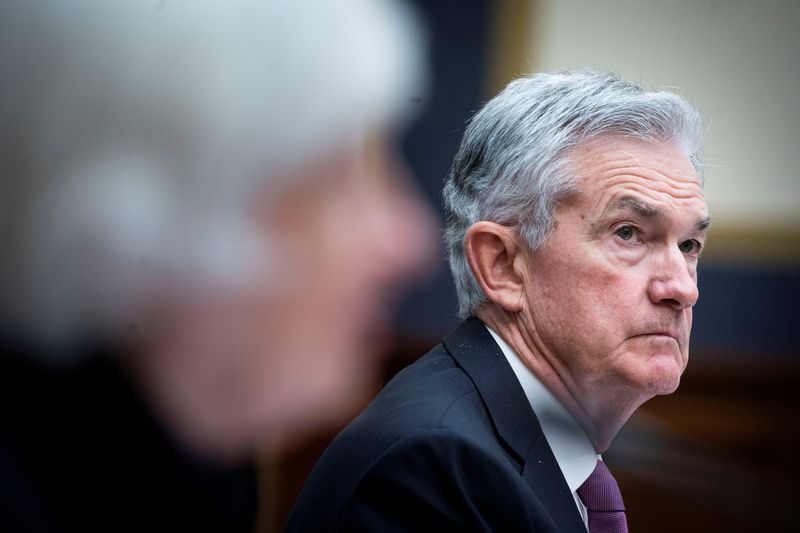Fed lays out plan to reduce bond purchases, flags inflation worries
3/3 © Reuters. FILE PHOTO: Federal Reserve Chair Jerome Powell attends the House Financial Services Committee hearing on Capitol Hill in Washington, U.S., September 30, 2021. Al Drago/Pool via REUTERS 2/3 By Ann Saphir, Jonnelle Marte and Lindsay (NYSE:LNN) Dunsmuir
(Reuters) -The Federal Reserve signaled on Wednesday it could start reducing its crisis-era support for the U.S. economy by the middle of next month, with a growing number of its policymakers worried that high inflation could persist longer than previously thought.
Though no decision on a “taper” of the U.S. central bank’s $120 billion in monthly asset purchases was reached at its Sept. 21-22 policy meeting https://www.reuters.com/business/finance/fed-likely-open-bond-buying-taper-door-hedge-outlook-2021-09-22, “participants generally assessed that, provided that the economic recovery remained broadly on track, a gradual tapering process that concluded around the middle of next year would likely be appropriate,” according to the minutes of that meeting.
With the economy set to grow this year at its fastest pace in decades, inflation riding well above the Fed’s comfort zone and the labor market much healed from the devastation of the coronavirus pandemic, Fed Chair Jerome Powell and his colleagues want to start cutting back on the bond-buying program the central bank put in place to spur the economic recovery from the coronavirus pandemic.
Policymakers discussed cutting the Fed’s purchases of Treasuries by $10 billion a month and those of mortgage-backed securities by $5 billion a month, said the minutes, which were released on Wednesday, though “several” participants preferred a faster reduction.
If a decision to begin tapering takes place at the Fed’s Nov. 2-3 policy meeting, the minutes said, the process could begin in either the middle of that month or mid-December.
In a change from readouts of Fed meetings over the summer, policymakers were no longer described as “generally” expecting inflation pressures to ease as transitory factors “dissipated.”
Instead, the minutes suggested there were intensifying worries within the Fed over inflation, with “most” policymakers now seeing upside risks, and “some” concerned about elevated inflation feeding through to inflation expectations or more broadly into prices.
Still, “several other” policymakers attributed upward price pressures to pandemic-related supply bottlenecks that could be expected to abate.
FOCUS ON RATES
With the wind-down in asset purchases imminent, attention now shifts to the timing of future interest rate hikes.
The Fed has promised to keep its benchmark overnight lending rate at the current near-zero level until the economy reaches full employment, and inflation has not only reached its 2% goal but is on track to stay modestly above that level for some time.
The central bank set those parameters when inflation had been running below 2% for years, and the big challenge was seen as lifting it up rather than tamping it down.
But now, the opposite problem may be emerging, as pent-up consumer demand fuels spending in a reopening economy and businesses, hobbled by supply bottlenecks, struggle to keep up.
In forecasts released alongside last month’s policy statement, half of Fed policymakers thought a rate hike would be needed before the end of next year, with all but one forecasting a first increase in borrowing costs before the end of 2023.
Key for investors – and the millions of Americans who still can’t find jobs – is the question of whether policymakers will need to begin raising rates earlier to stop inflation from spiraling upward, potentially sacrificing labor market gains in the process.
Powell has played down the possibility of being forced into that uncomfortable position.
But the data may be trending against him. U.S. consumer prices rose 5.4% in the 12 months through September https://www.reuters.com/world/us/us-consumer-prices-increase-solidly-september-2021-10-13, the U.S. government reported on Wednesday, and traders of interest rate futures boosted their bets that the Fed would have to start lifting rates by next September.
In the minutes, “various” policymakers thought that economic conditions would likely justify keeping rates near their current level for “the next couple of years.” A “number,” however, felt rates would need to rise by the end of next year because they felt it would have reached full employment; “some” also thought inflation would remain elevated with risks to the upside, the minutes showed.











 Bitcoin
Bitcoin  Ethereum
Ethereum  XRP
XRP  Tether
Tether  Solana
Solana  USDC
USDC  Lido Staked Ether
Lido Staked Ether  Dogecoin
Dogecoin  TRON
TRON